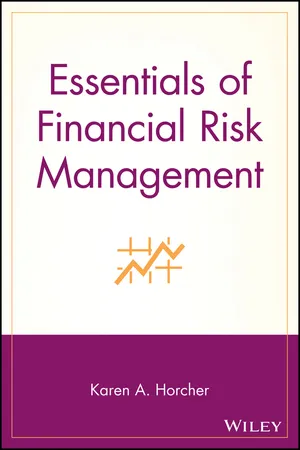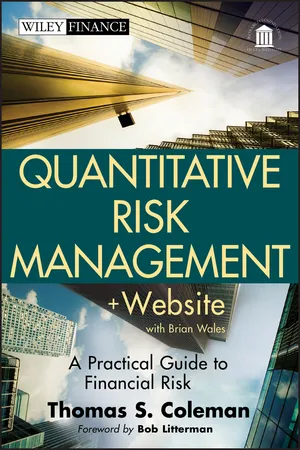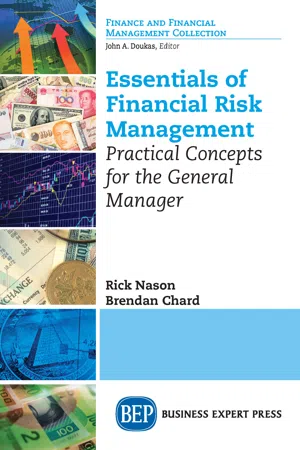Economics
Financial Risk Management
Financial risk management involves identifying, analyzing, and addressing potential risks that could impact an organization's financial health. This includes assessing and mitigating risks related to market fluctuations, credit exposure, liquidity, and operational factors. The goal is to minimize the impact of adverse events on the organization's financial performance and stability.
Written by Perlego with AI-assistance
Related key terms
7 Key excerpts on "Financial Risk Management"
- eBook - ePub
- Karen A. Horcher(Author)
- 2011(Publication Date)
- Wiley(Publisher)
CHAPTER 1 What Is Financial Risk Management?After reading this chapter you will be able to- Describe the Financial Risk Management process
- Identify key factors that affect interest rates, exchange rates, and commodity prices
- Appreciate the impact of history on financial markets
Although financial risk has increased significantly in recent years, risk and risk management are not contemporary issues. The result of increasingly global markets is that risk may originate with events thousands of miles away that have nothing to do with the domestic market. Information is available instantaneously, which means that change, and subsequent market reactions, occur very quickly.The economic climate and markets can be affected very quickly by changes in exchange rates, interest rates, and commodity prices. Counterparties can rapidly become problematic. As a result, it is important to ensure financial risks are identified and managed appropriately. Preparation is a key component of risk management.What Is Risk?Risk provides the basis for opportunity. The terms risk and exposure have subtle differences in their meaning. Risk refers to the probability of loss, while exposure is the possibility of loss, although they are often used interchangeably. Risk arises as a result of exposure.Exposure to financial markets affects most organizations, either directly or indirectly. When an organization has financial market exposure, there is a possibility of loss but also an opportunity for gain or profit. Financial market exposure may provide strategic or competitive benefits.Risk is the likelihood of losses resulting from events such as changes in market prices. Events with a low probability of occurring, but that may result in a high loss, are particularly troublesome because they are often not anticipated. Put another way, risk is the probable variability of returns. - eBook - ePub
A Risk Professional's Survival Guide
Applied Best Practices in Risk Management
- Clifford Rossi(Author)
- 2014(Publication Date)
- Wiley(Publisher)
CHAPTER 2 Overview of Financial Risk ManagementRISK MANAGEMENT DEFINED
Risk management describes a collection of activities to identify, measure, and ultimately manage a set of risks. People and organizations confront risks every day: For example, an individual decides to leave a relatively secure job for another with better opportunity and compensation across country, a government faces the threat of terrorist attacks on public transportation, or a bank determines which financial products it should offer to customers. While some risks are fairly mundane and others a matter of life or death at times, the fundamental process for assessing risk entails evaluation of trade-offs of outcomes depending on the course of action taken. The complexity of the risk assessment is a function of the potential impact from a particular set of outcomes; the individual deciding to take a different job is likely to engage in a simpler risk assessment, perhaps drawing up a pros and cons template, while a government facing terrorist threats might establish a rigorous set of quantitative and surveillance tools to gather intelligence and assign likelihoods and possible effects to a range of outcomes.Regardless of the application or circumstance, each of the assessments above has a common thread, namely, the assessment of risk. But what exactly is risk and is it the same across all of these situations? Risk is fundamentally about quantifying the unknown. Uncertainty by its very nature tends to complicate our thinking about risk because we cannot touch or see it although it is all around us. As human beings have advanced in their application of technology and science to problem solving, a natural evolution to assessing risk using such capabilities has taken place over time. Quantifying uncertainty has taken the discipline of institutional risk management to a new level over the past few decades with the acceleration in computing hardware and software and analytical techniques. - eBook - ePub
Credit Risk
Pricing, Measurement, and Management
- Darrell Duffie, Kenneth Singleton(Authors)
- 2012(Publication Date)
- Princeton University Press(Publisher)
2
Economic Principles of Risk Management
WHY DO MANAGERS of financial institutions care about financial risks? Are the economic incentives for managing market and credit risks the same, or does credit risk present different challenges, calling for distinct measurement systems or tools? These are some of the questions that we begin to address in this chapter. The economics of risk management for financial firms is far from an exact science. While rigorous and empirically testable models can be brought to the task of measuring financial risks, some of the benefits and costs of bearing these risks are difficult to quantify.In a hypothetical world of perfect capital markets—as we know from the work of Modigliani and Miller (1958), widely held to be the basis for the Nobel prizes awarded to Franco Modigliani and Merton Miller—any purely financial transaction by a publicly traded firm has no impact on that firm’s total market value. Capital markets, however, are not perfect. Market imperfections underlie significant benefits for banks and other financial institutions for bearing and controlling financial risks. Indeed, we name and characterize many of these benefits. One should not, however, anticipate a model allowing a practical cost-benefit analysis of risk that leads to precise quantitative trade-offs. Some of the important channels through which risk operates to the detriment or benefit of a financial corporation are not readily priced in the market.For instance, there are no obvious formulas to determine the market value that can be created by a financial firm willing to bear a given amount of risk through proprietary trading or intermediation. In perfect capital markets, after all, securities are priced at their fair market values, and trading could therefore neither add nor subtract market value. Any such formula relating financial risk bearing to the market value of the firm would, in the reality of imperfect capital markets, depend on such difficult-to-capture variables as the human abilities of traders and management, the information flows available to the firm, its reputation, its access to customers, and its organization of the risk-management function itself, not to mention a host of economic variables that characterize its economic environment. - eBook - ePub
Quantitative Risk Management
A Practical Guide to Financial Risk
- Thomas S. Coleman(Author)
- 2012(Publication Date)
- Wiley(Publisher)
Part One Managing RiskPassage contains an image Chapter 1 Risk Management versus Risk Measurement
Managing risk is at the core of managing any financial organization. This statement may seem obvious, even trivial, but remember that the risk management department is usually separate from trading management or line management. Words matter, and using the term risk management for a group that does not actually manage anything leads to the notion that managing risk is somehow different from managing other affairs within the firm. Indeed, a director at a large financial group was quoted in the Financial Times as saying that “A board can't be a risk manager.”1 In reality, the board has the same responsibility to understand and monitor the firm's risk as it has to understand and monitor the firm's profit or financial position.To repeat, managing risk is at the core of managing any financial organization; it is too important a responsibility for a firm's managers to delegate. Managing risk is about making the tactical and strategic decisions to control those risks that should be controlled and to exploit those opportunities that can be exploited. Although managing risk does involve those quantitative tools and activities generally covered in a risk management textbook, in reality, risk management is as much the art of managing people, processes, and institutions as it is the science of measuring and quantifying risk. In fact, one of the central arguments of this book is that risk management is not the same as risk measurement. In the financial industry probably more than any other, risk management must be a central responsibility for line managers from the board and CEO down through individual trading units and portfolio managers. Managers within a financial organization must be, before anything else, risk managers in the true sense of managing the risks that the firm faces. - eBook - ePub
Financial Risk Management
A Practitioner's Guide to Managing Market and Credit Risk
- Steve L. Allen(Author)
- 2012(Publication Date)
- Wiley(Publisher)
CHAPTER 6 Managing Financial Risk The management of financial risk can be divided into two parts: risk measurement and risk control. In general, the industry agrees more on how risk should be measured than on how it should be controlled. 6.1 RISK MEASUREMENT 6.1.1 General Principles As stated in Chapter 1, the key characteristic that distinguishes Financial Risk Management from other types of risk management is that Financial Risk Management can take advantage of liquid markets as part of a risk management strategy. In this chapter we examine the structure of Financial Risk Management in more detail, and a good starting point is to consider the hypothetical case in which a market is so liquid that any position can be liquidated instantaneously. While this is obviously an extreme that does not exist in reality, it will still provide an instructive background against which to consider more realistic cases. With such perfect liquidity, risk management could, in principle, just consist of setting loss limits for each trader and each trading group (the industry jargon for this is a stop-loss limit). As soon as a trader reached the limit for a position, the entire position could be liquidated with no further loss. Or if management decided that its risk tolerance had changed because of changes in their view of the economy or the institutional environment, positions could be liquidated with no further losses. Even in such an extreme case, the following rules would be needed. Careful and continuous tracking of market prices of existing positions. Otherwise, you would not know when a trader was through a stop-loss limit. Traders may be tempted to hide the size of their losses, knowing that being through a limit will cause the position to be closed out and eliminate their chance of making future gains. An optimistic mark of the position could delay the recognition of losses - eBook - ePub
- Rick Nason, Brendan Chard(Authors)
- 2018(Publication Date)
- Business Expert Press(Publisher)
CHAPTER 2 Financial Risk Management Tools and Tactics Responses to RiskBefore beginning a discussion of the various tools and tactics used to manage financial risks, it is instructive to review the range of possible responses to financial risks. It is appropriate to realize that there is a range of responses to risk: eliminate, avoid, mitigate, ignore, embellish, and embrace.1 These responses range from weak (mitigate, embellish) to neutral (ignore), to strong (eliminate, embrace), and also reflect the philosophy that risk can be positive as well as negative. Just as the responses to risk have a range, so too do the Financial Risk Management tools. Furthermore, just as it is important in any type of craftsmanship to choose the right tool for the task, so it is in Financial Risk Management.Part of choosing the tool for risk management depends on whether the risk is predominately a negative risk, or predominantly a positive risk. Not always, but generally in Financial Risk Management, a risk that is a negative risk for one organization is a positive risk for a different organization. A second component is understanding the side effects, or the unintended consequences of a risk tool. An old saying about Financial Risk Management is that the “only perfect hedge is in a Japanese Garden.” Virtually all risk tools either have an explicit cost or some unintended consequence that renders the risk tool as less than perfect. That is simply the nature of risk management. That is not to say that one should not use risk management tools, but one does need to know the respective advantages and drawbacks of the various tools available to the risk manager.Operational Financial Risk Management StrategiesThere are several operational strategies for managing financial risk. For instance, operations can be designed to offset currency risks; financing can be arranged to minimize interest rate risk; sales contracts can be set to reduce commodity price risk. The way an organization chooses to implement its operations can provide a wide variety of risk benefits. - Torben Juul Andersen(Author)
- 2015(Publication Date)
- Routledge(Publisher)
Harrison and Phillips (2014 : p. 164): “it was apparent from the serious economic journalism of 2006, 2007 and early 2008 that there were many ‘canaries in the cave’ that anticipated the landscape of the financial crisis of 2008.” In other words, there is a tendency to ignore even the most obvious signs of emergent risk events. With a bit of luck, this is what risk management practices might be able to circumvent by creating more risk conscious organizational settings.Strategic risk management is a conceptual extension of risk management indicating that risk management somehow has become strategic. Using the term strategic may simply indicate that the derived concept is considered important with the aim of giving it a more imposing flair (Andersen, 2013 ). Risk management is typically conceived as the structured process of identifying and dealing with risks followed by monitoring and controls to minimize the negative downside effects of risk events and to maximize the positive upside potential of opportunities in line with corporate objectives.1 Hence, according to the Institute of Risk Management (IRM), risk is the probability of an event and its consequences that can have both positive and negative outcomes. It is argued that anything that may obstruct, or create uncertainty about the ability to achieve organizational objectives at the strategic, tactical and operational levels constitutes a risk. COSO (2004) 2 describes enterprise risk management (ERM) as a process initiated by the board of directors involving management and personnel across the enterprise to identify potential risk events and manage them within a given risk appetite to ensure that organizational objectives can be achieved. These views establish a potential link between the risk management process and the ability to achieve intended outcomes that are considered to be of strategic importance. A recent practice-based view (PBV) of strategy scholarship (Bromiley and Rau, 2014
Learn about this page
Index pages curate the most relevant extracts from our library of academic textbooks. They’ve been created using an in-house natural language model (NLM), each adding context and meaning to key research topics.






